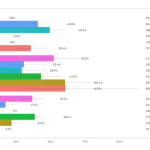The Path to 100 Gigawatts: How India Has Emerged as a Global Leader in Solar Energy
India has surpassed Japan to become the world’s third-largest market for solar power, and it’s projected to claim the number two spot from the United States later this year. The country aims to increase its renewable capacity to 100 gigawatts (GW) by the end of 2022, amid government support to meet the burgeoning energy needs of its cities, villages and towns.
Along with initiatives by the government, the renewable energy industry is seeing keen participation from some private players, including Tata Power and Adani Solar. Mundra Solar PV, the solar photovoltaic manufacturing arm of the industrial conglomerate Adani Group, is aiming to become a billion-dollar company in the next three years. Headed by Gautam Adani and Rajesh Adani, the company is in the process of ramping up its manufacturing capacity of cells and modules from 1,200 to 3,000 megawatts (MW).
Tata Power Ltd, one of India’s largest private power conglomerates, has also made significant progress into the renewable energy sector. Although renewable energy – specifically solar energy – is a small part of it, the company will be investing $5 billion to quadruple its renewable capacity. This means a total of 12,000 MW will be added to its capacity by 2028, explains Praveer Sinha, the CEO of Tata Power. “Renewables is our big space. This is something that we want to go big in,” says Sinha. “The bulk of the increase will come from solar. It will be utility level large projects as well as residential and commercial rooftops.”
India’s Solar Industry Rebounds
These developments represent a major turnaround for India’s solar industry. Earlier last year, the country’s indigenous solar equipment manufacturers were experiencing a financial collapse, due to Chinese competitors.
These companies had been meeting 85 percent of India’s solar module demand, raking in $2 billion in yearly revenues in the process. Indian companies, such as IndoSolar, Moser Baer India, Jupiter Solar, etc., were struggling to win contracts. If left unaddressed, the market share loss to Chinese competitors could have been more than $10 billion.
But the above developments hint at a gradual Indian overtake of the Chinese monopoly in the solar energy and photovoltaic cell production industry. Adani Solar’s CEO Ramesh Nair explains, “Manufacturing in India will have to increase, as we cannot continue with letting Chinese products being dumped here. With the recent decisions taken and the government’s vision of 100 GW of solar capacity by 2022, manufacturing capacities in India will increase.”
The ‘Eighth Wonder of the World’
This momentum comes not a moment too soon. India desperately needs green energy to power its ever-expanding population and fast-growing economy. To meet the country’s energy needs and its climate change mitigation commitments in the Paris Agreement, renewable energy needs to be supplied steadily.
Air pollution has reached dangerous levels, and the bulk of electricity in India is still created by coal-fueled thermal power stations: According to government records, 58 percent of the country’s energy requirements are met by these thermal power stations, and just 5 percent are provided by solar farms.
But those numbers are likely to change, as plans for 14 new solar parks have been approved by the government. The most ambitious of these projects, the Pavagada Solar Park, is progressing fast: When completed, it is set to become the world’s largest solar park, producing 2,000 MW, which could be sufficient to electrify 700,000 households. One government official already refers to the massive project as “the Eighth Wonder of the World.” The global industry is increasingly taking note of the growing opportunities for solar projects in India, as confirmed by the interest of international energy juggernauts like Fortum, First Solar and Sol System.
Still, there are challenges that need to be addressed if India wishes to reach the 100 GW mark. For one thing, there’s a lack of land that can support the ongoing increase in solar farms. And since the adoption of a new national goods and services tax, the cost of solar panels and related equipment has increased.
Nevertheless, the sector’s momentum continues. The state of Maharashtra recently launched a tender for 1 GW of solar farms, which will invite hordes of clean energy companies to compete for multiple contracts across 20 districts in the state. It’s one more sign that the clean energy future of India is becoming a reality, and that the government remains committed to working with private companies to keep the country’s renewable energy revolution on track.
Sahaj Desai is a writer based in Delhi, India.
Photo of Kamuthi Solar Park in India courtesy of Wikimedia Commons.
- Categories
- Energy



